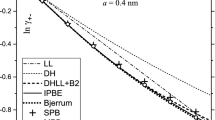Abstract
The system of equations of the Onsager treatment of conductance is rederived in a systematic way by the use of several sets of hierarchy equations generalizing to other quantities the classical Born-Bogoliubov-Green-Kirkwood-Yvon (BBGKY) hierarchy of internal force. The “monitoring” term of the Onsager continuity equation obtained is compared to former theoretical studies. It is inferred in particular that the perturbation on the anion-cation pair distribution for a symmetrical binary electrolyte is proportional not only to the external fieldX but also to the conductance coefficientf A=1+δX/X+Λ el/Λ 0. This result, called the “echo” effect, leads to a new formulation of molar conductance which shows a great similarity to the empirical conductance function obtained by grafting the chemical model of Bjerrum onto the conductance equations derived on the basis of the Debye approximations as proposed formerly by the author from experimental observations. The result allows a simple generalization of the conductance equation to any direct short-range anion-cation energy-potential model.
Similar content being viewed by others
References
P. Debye and H. Falkenhagen,Phys. Z. 29, 401 (1928).
W. Ebeling,Wiss. Z. Univ. Rostock Math. Naturwiss. Reihe 14, 271 (1965);Ann. Phys., Leipzig 16, 1947 (1965).
E. Pitts,Proc. Roy. Soc. London 217, 43 (1953).
E. Pitts, B. E. Tabor, and J. Daly,Trans. Faraday Soc. 65, 849 (1969).
R. M. Fuoss and L. OnsagerJ. Phys. Chem. 61, 668 (1957).
R. M. Fuoss, L. Onsager, and J. F. Skinner,J. Phys. Chem. 69, 2581 (1965).
R. M. Fuoss and K. L. Hsia,Proc. Nat. Acad. Sci. U.S.A. 57, 1550, 1818 (1967).
R. M. Fuoss,J. Phys. Chem. 79, 525 (1975).
T. J. Murphy and E. G. D. Cohen,J. Chem. Phys. 53, 2173 (1970).
J. Quint and A. Viallard,J. Chim. Phys. 69, 1100 (1972).
R. M. Fuoss,J. Phys. Chem. 63, 633 (1959).
R. M. Fuoss and F. Accascina, inElectrolytic Conductance (Interscience Publishers, Inc., New York, 1959).
H. Falkenhagen, W. Ebeling, and W. D. Kraeft, “Transport Properties of Dilute Electrolytes,” inIonic Interactions, S. Petrucci, ed. (Academic Press, New York, 1971).
W. Ebeling, Private communication to be published inJ. NonEquil. Thermodyn.
P. C. Carman,J. S. Afr. Chem. Inst. 28, 80 (1975);J. Solution Chem. 6, 609 (1977);7, 845 (1978).
J.-C. Justice,J. Chim. Phys. 65, 353 (1968).
M.-C. Justice and J.-C. Justice,J. Solution Chem. 5, 543 (1976).
J.-C. Justice and W. Ebeling, submitted toJ. Solution Chem.
M.-C. Justice and J.-C. Justice,J. Solution Chem. 6, 819 (1977).
J. Perie, M. Perie, and J.-C. Justice, to be submitted toJ. Solution Chem.
Author information
Authors and Affiliations
Rights and permissions
About this article
Cite this article
Justice, JC. Ionic interactions in solutions. III. Derivation of the ″associated″ electrolyte formulation from the Onsager treatment of conductance. J Solution Chem 7, 859–875 (1978). https://doi.org/10.1007/BF00650813
Received:
Revised:
Issue Date:
DOI: https://doi.org/10.1007/BF00650813




